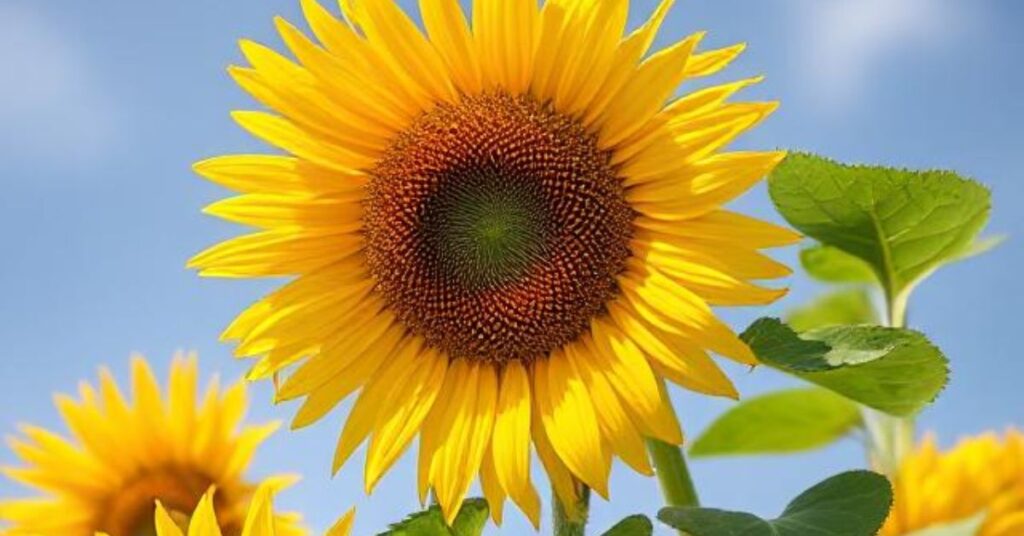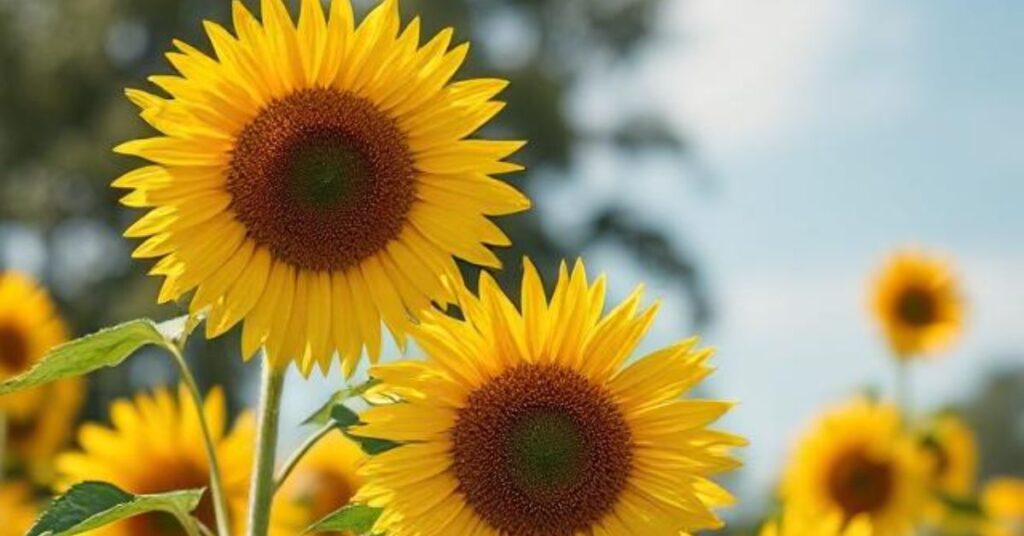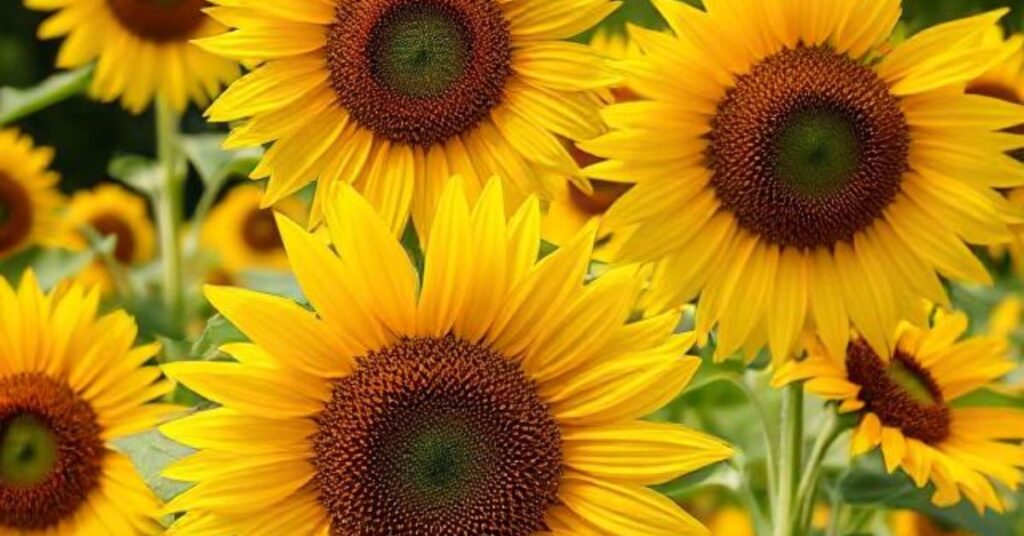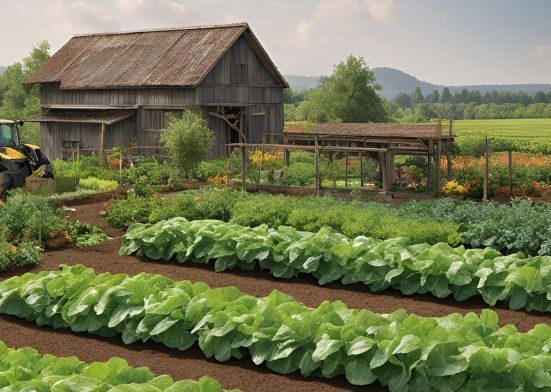Sunflowers, with their towering stems and radiant, sun-like blooms, are beloved in gardens, fields, and even art. Their cheerful presence evokes warmth and vitality, making them a favorite among gardeners and nature enthusiasts. However, a common question arises: Are sunflowers perennials? Do these vibrant plants return year after year, or is their beauty a fleeting summer affair?This in-depth blog post will explore the lifetime of sunflowers, clarify their classification, and provide practical tips for growing and enjoying them in your garden. By the end, you’ll thoroughly understand sunflowers and how to make the most of their sunny charm.
Understanding Sunflowers: Annuals or Perennials?
To answer the question directly: most sunflowers are annuals, meaning they complete their lifecycle in a single growing season. However, there are exceptions, as some sunflower species are perennials, returning year after year. Let’s break this down to understand the distinction and explore the characteristics of both types.
What Are Annual Sunflowers?
Annual sunflowers, including the iconic Helianthus annuus (common sunflower), grow, bloom, produce seeds, and die within one year. These plants are known for their rapid growth, often reaching 6 to 12 feet in just a few months. Their large, daisy-like flower heads attract pollinators like bees and butterflies, and their seeds are a valuable food source for birds, wildlife, and humans.
Key traits of annual sunflowers:
- Lifecycle: Germinate, grow, flower, and set seed in one season (typically spring to fall).
- Height: Can grow anywhere from 3 to 15 feet, depending on the variety.
- Bloom Time: Usually mid-to-late summer, with flowers lasting several weeks.
- Popular Varieties: ‘Mammoth Russian,’ ‘Sunrich,’ ‘Teddy Bear,’ and ‘Autumn Beauty.’
Because annual sunflowers complete their lifecycle in one season, gardeners must replant them yearly. However, their seeds often self-sow, Hybrid Farming: The Future of Sustainable Agriculture meaning they drop to the ground and may sprout the following spring under favorable conditions.
When do Sunflowers Bloom

Sunflowers typically bloom between mid-summer and early fall, depending on the variety and planting time. Most sunflowers start blooming about 70 to 100 days after planting. You can expect blooms by July or August if planted in late spring.Early-maturing varieties may bloom sooner, while taller or perennial types may take longer. Warmer climates can also lead to earlier blooming.
What Are Perennial Sunflowers?
While less common, perennial sunflowers return each year from their root systems. These species, such as Helianthus maximiliani (Maximilian sunflower) and Helianthus salicifolius (willow-leaved sunflower), are hardy plants that can thrive for several years in the right conditions. Perennial sunflowers tend to have smaller flowers than their annual counterparts but often produce clusters of blooms, creating a striking display.
Key traits of perennial sunflowers:
- Lifecycle: Regrows each spring from roots, blooms annually for multiple years.
- Height: Typically 4 to 8 feet, though some varieties are shorter or taller.
- Bloom Time: Late summer to fall, often later than annual sunflowers.
- Popular Varieties: ‘Lemon Queen,’ ‘Sunchaser,’ and ‘Capenoch Star.’
Perennial sunflowers are low-maintenance and ideal for gardeners seeking long-term landscape additions. They spread through underground rhizomes, which can make them somewhat aggressive in specific settings, so careful placement is key.
Why the Confusion?
The annual versus perennial distinction can be confusing because are sunflowers fall flowers belong to the Helianthus genus, which includes over 70 species, Top Tips For Better Surface Irrigation Systems some annual and some perennial. Additionally, the self-seeding nature of annual sunflowers can give the impression that they return year after year, when new plants are sprouting from fallen seeds. Knowing the specific variety you’re growing is essential to understanding its lifecycle.
The Sunflower Lifecycle: A Closer Look
Let’s explore their lifecycle to fully appreciate whether sunflowers are annuals or perennials. Understanding how sunflowers grow and reproduce provides insight into their care and cultivation.
Germination
Sunflower seeds germinate in warm soil when temperatures reach 50°F (10°C) or higher. Annual sunflowers are often planted in spring after the last frost, while perennial sunflowers emerge from their roots simultaneously. Seeds require well-drained soil and plenty of sunlight to sprout successfully.
Vegetative Growth
Once sprouted, sunflowers enter a rapid growth phase. Annual sunflowers are particularly fast growers, sometimes adding inches to their height daily under ideal conditions. Their broad leaves capture sunlight, fueling the production of strong stems and buds. Perennial sunflowers grow more slowly but establish robust root systems that support their longevity.
Flowering
Sunflowers typically bloom in mid-to-late summer, though The climate and variety determine the precise timing. or inflorescences, consist of hundreds of tiny florets arranged in a spiral pattern. These florets attract pollinators, which facilitate seed production. What Is Agriculture A Simple Guide Annual sunflowers often produce a single, large flower head, while perennials may produce multiple smaller heads.
Seed Production
After pollination, sunflowers develop seeds in the center of their flower heads. Annual sunflowers produce seeds that can be harvested for planting, eating, or feeding wildlife. Perennial sunflowers also produce seeds, but their primary mode of reproduction is through rhizomes, which spread underground and give rise to new shoots.
Senescence (Annuals) or Dormancy (Perennials)
For annual sunflowers, the end of the growing season marks the end of their lifecycle. The plant dies, leaving behind seeds that may sprout the following year. Perennial sunflowers, on the other hand, enter dormancy in fall, with their roots surviving underground through winter. In spring, new shoots emerge, beginning the cycle anew.
Growing Sunflowers: Tips for Annuals and Perennials

Whether you’re planting annual or perennial sunflowers, their care requirements are similar, though perennials demand a bit more planning due to their spreading nature. Boosting Soil Health Here are practical tips for growing healthy, vibrant sunflower fields in your garden.
Choosing the Right Variety
- Annual Sunflowers: Opt for varieties that suit your space and aesthetic. Dwarf varieties like ‘Teddy Bear’ (2–3 feet) are great for small gardens, while giants like ‘Mammoth Russian’ (10–12 feet) make bold statements in larger spaces.
- Perennial Sunflowers: Choose varieties like ‘Lemon Queen’ for sunny borders or ‘Maximilian’ for naturalistic landscapes. Be mindful of their spreading habit and allocate enough space.
Planting Sunflowers
- Timing: Plant annual sunflower seeds in spring after the last frost, when soil temperatures are at least 50°F (10°C). Perennial sunflowers can be planted in spring or fall, allowing roots to establish before extreme weather.
- Location: Sunflowers thrive in full sun, requiring at least 6–8 hours of direct sunlight daily. Choose a spot with well-drained soil, as soggy conditions can lead to root rot.
- Soil: Sunflowers prefer loamy, fertile soil with a pH of 6.0–7.5. Amend poor soil with compost or organic matter to boost fertility.
- Spacing: Space annual sunflowers 1–2 feet apart, depending on the variety. Perennial sunflowers need more room (2–3 feet) to accommodate their spreading roots.
Watering and Fertilizing
- Watering: When germination is taking place, keep the soil damp but not soggy. and early growth. Once established, sunflowers are drought-tolerant but benefit from occasional deep watering during dry spells.
- Fertilizing: Apply a balanced fertilizer (e.g., 10-10-10) at planting and again when buds form for annual sunflowers. Perennials need less fertilization but benefit from a light application of compost in spring.
Supporting Tall Sunflowers
Tall annual varieties, like ‘Mammoth Russian,’ may require staking to prevent toppling in windy conditions. Use bamboo stakes or garden trellises, Modern Commercial Agriculture: securing stems with soft ties. Perennial sunflowers are generally sturdier but may need support in exposed areas.
Managing Pests and Diseases
Sunflowers are pest-resistant but can attract aphids, caterpillars, or birds eager for seeds. Use neem oil for insect control and cover flower heads with mesh bags to protect seeds. Making sure there is adequate air circulation will help reduce common diseases like rust and powdery mildew. and avoiding overhead watering.
Pruning and Maintenance
- Annual Sunflowers: Deadhead spent blooms to encourage additional flowering in branching varieties. Remove dead plants at the end of the season to prevent disease buildup.
- Perennial Sunflowers: Cut back stems to the ground in late fall after foliage dies back. Split clumps in the spring every three to four years to control the spread and rejuvenate plants.
Creative Uses for Sunflowers
Sunflowers aren’t just garden showstoppers; they have a range of practical and creative uses:
- Culinary: Roast sunflower seeds for a nutritious snack or use them in baked goods. Sunflower petals are edible and add color to salads.
- Wildlife Habitat: Sunflowers attract pollinators and provide seeds for birds, supporting local ecosystems.
- Decor: Use cut common sunflower blooms in bouquets or dried heads in wreaths and crafts.
- Companion Planting: Plant sunflowers alongside vegetables like cucumbers or beans to provide shade and attract beneficial insects.
Sunflowers in Culture and Symbolism
Sunflowers hold a special place in art, literature, and culture. Vincent van Gogh’s famous Sunflowers paintings capture their vibrant beauty, while their heliotropic nature (turning to face the sun) symbolizes positivity, loyalty, and resilience. In many cultures, sunflowers represent harvest, abundance, and the sun’s life-giving power.
Growing Tips for Healthy Sunflowers
Sunflowers are relatively easy to grow, but following key tips will ensure strong stems, vibrant blooms, and healthy growth throughout the season. First, choose a sunny location—sunflowers They need at least six to eight hours of direct sunlight per day to flourish. The soil should be somewhat fertile and well-draining. Even though sunflowers can grow in poor soil, the results can be enhanced by adding compost or other organic matter before planting.Plant seeds directly into the ground if the soil temperature has reached a minimum of a certain degree after the previous frost. 55–60°F (13–16°C). Space them 6 to 24 inches apart, depending on the variety.To promote robust root development, water deeply but sparingly. Root rot may result from excessive irrigation or inadequate drainage.
Support taller varieties with stakes to prevent them from falling over, especially in windy areas. Fertilizing isn’t always necessary, but a balanced, slow-release For a boost, fertilizer can be applied in the early stages of growth.Watch out for typical pests like as caterpillars and aphids. Insecticidal soap or neem oil can assist with natural pest control. Finally, remove weeds regularly to reduce competition and keep the area around your sunflowers clean and aerated.
When is The Season for Sunflowers

The season for sunflowers is typically from mid-summer to early fall, with peak blooming occurring between July and September in most regions.common sunflower are usually planted in late spring, after the last frost, and bloom 70–100 days later, depending on the variety and climate. In warmer regions, the blooming season may start earlier, while cooler areas may see blooms later into the season.
Harvesting and Seed Saving
Harvesting sunflowers at the right time is essential for enjoying or saving their seeds for future planting. Most sunflowers are ready to harvest when the backs of their flower heads turn The petals start to wilt and fall off, turning yellow or brown. The seeds will appear plump and slightly loose in their sockets. You can also rub a few seeds to see if they come off easily.Cut the flower head 12 to 18 inches down the stalk to harvest. An area that is dry and well-ventilated and not exposed to direct sunlight hang the heads upside down. sunlight. Place a paper bag or mesh cloth around the head to catch falling seeds.
Once the seeds are thoroughly dried (after about 1–2 weeks), rub them off by hand or use a stiff brush. For seed saving, choose seeds from the healthiest, most vigorous plants to ensure quality in the next generation. Store seeds inside an airtight container or envelope in a cool, dark place. Label them with the date and variety.Avoid saving seeds from hybrid varieties, as they may not produce true-to-type plants. Instead, use heirloom or open-pollinated types for reliable results.sunflowers for sale near me
Conclusion
So, are sunflowers perennials? The answer depends on the species. Most sunflowers, like the classic Helianthus annuus, are annuals, offering a single season of spectacular growth and blooms. However, perennial varieties like Helianthus maximiliani provide years of reliable beauty with less replanting effort. Both types have charm, and choosing between them depends on your gardening goals and space.
Whether planting a row of towering annuals or a patch of hardy perennials, sunflowers bring joy and vibrancy to any landscape. With proper care, these sun-worshipping plants will reward you with stunning blooms, wildlife visitors, and perhaps a handful of seeds to share or savor. So grab some seeds, find a sunny spot, and let sunflowers brighten your world!
FAQ
1. Are all sunflowers annuals?
No, not all sunflowers are annuals. While most common varieties are annuals, some species like Helianthus maximiliani are perennials and can return year after year with proper care.
2. When should I plant sunflower seeds?
Plant sunflower seeds outdoors after the last frost, when soil temperatures reach 55–60°F (13–16°C). This usually falls in late spring, depending on your location and climate zone.
3. How much sunlight do sunflowers need?
Six to eight hours of direct sunlight are necessary for sunflowers. every day at the very least. They grow best in full sun, which helps them develop strong stems and large, vibrant blooms.
4. Do sunflowers need fertilizer?
Sunflowers can grow in poor soil, but adding During early growth, compost or a balanced fertilizer can increase size. can boost size and health. Avoid over-fertilizing, as it may cause weak stems.
5. How do I save sunflower seeds for next year?
Dry-harvest sunflower heads in a ventilated area. Once seeds loosen, remove and store them stored in an airtight container with a date label and variety. Keep in a cool, dark place.







